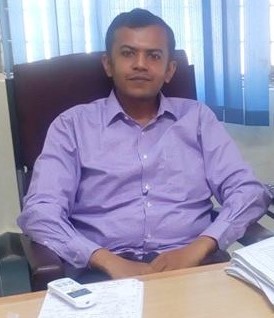
Dr. Manish Jain
Department of Applied Chemistry
Phone:0
Email: manishjain@dtu.ac.in
Qualifications
PhD
Areas of Interest
Membrane based separation processes , Transport Phenomena, Polymer Technology
EDUCATION: EXPERIENCE: PUBLICATIONS: Google Scholar Profile L. Gautam, S.G. Warkar, M. Jain, Evaluating the Role of Carboxylic Acid Cross-linkers in PVA Matrices for Adsorptive Removal of Crystal Violet Dye, ChemistrySelect 10:25 (2025) e00799. https://doi.org/10.1002/slct.202500799 Y. Katiyar, S. Sangwan, G. Sharma, M. Kumar, A. Goyal, M. Jain, D. Meena, Ag@SnO2/g-C3N4 Ternary Nanocomposite as an Efficient Acetone Vapors Sensor, ChemistrySelect 10:23 (2025) e04081. https://doi.org/10.1002/slct.202404081 K. Mahawer, A.K. Tiwari, A. Mutto, M. Jain, Modeling and experimental investigation of factors responsible for maximizing the betanin concentration by spiral-wound FO module using Na2SO4-based draw solution, Food and Bioproducts Processing 152 (2025) 54-63. https://doi.org/10.1016/j.fbp.2025.05.001 P.K. Meena, J.G. Sharma, M. Jain, Recovery of Whey Protein by Using Microfiltration: Artificial Neural Network-Based Modeling and Effects of Different Operating Parameters, Journal of Food Process Engineering 47:10 (2024) e14756. https://doi.org/10.1111/jfpe.14756 L. Gautam, M. Jain, S.G. Warkar, Crosslinking of polyvinyl alcohol with di, tri, and tetracarboxylic acids: an experimental investigation, Colloid and Polymer Science (2024). https://doi.org/10.1007/s00396-024-05313-3 K.H. Ruzvidzo, R. Kaur, M. Jain, Enhanced forward osmosis desalination of brackish water using phase-separating ternary organic draw solutions of hydroxypropyl cellulose and propylene glycol propyl ether, Water Environment Research 96:8 (2024) e11110. https://doi.org/10.1002/wer.11110 L. Gautam, S.G. Warkar, M. Jain, Influence of the odd-even effect of dicarboxylic acids as crosslinker on the physicochemical properties of polyvinyl alcohol, Journal of Applied Polymer Science 141:40 (2024) e56046. https://doi.org/10.1002/app.56046 K.H. Ruzvidzo, R. Kaur, M. Jain, Novel polyelectrolyte-glycol ether ternary phase-separating draw solutions for desalination using forward osmosis, Desalination 586 (2024) 117897. https://doi.org/10.1016/j.desal.2024.117897 D. Meena, M. Jain, M.C. Bhatnagar, Resistive gas sensors based on nanostructured ternary metal oxide: a review, Journal of Materials Science 59(2024)12177-12218. https://doi.org/10.1007/s10853-024-09903-y A.K. Tiwari, M. Jain, Concentration of betanin from model beetroot extracts by using nanofltration: parameter estimation and sensitivity analysis, Journal of Chemical Technology and Biotechnology 99:9 (2024)1976-1983. https://doi.org/10.1002/jctb.7698 L. Gautam, S.G. Warkar, M. Jain, Physicochemical evaluation of polyvinyl alcohol films crosslinked with saturated and unsaturated dicarboxylic acids: A comparative study, Polymer Engineering and Science 64(2024 )3703-3715. https://doi.org/10.1002/pen.26806 A.K. Tiwari, M. Jain, A novel process for rutin recovery from model solutions using nanofiltration: Experimental study, mathematical modeling, and scale-up design, Journal of Food Process Engineering 47 (2024) e14592. https://doi.org/10.1111/jfpe.14592 J. Iqbal, A. Tyagi, M. Jain, Artificial neural network based modeling of liquid membranes for separation of dysprosium, Journal of Rare Earths 41-3 (2023) 440-445. https://doi.org/10.1016/j.jre.2021.12.007 H. Gupta, A. Gosain, A. Batra, M. Jain, Artificial Neural Network-Based Modeling of Membrane Contractors for Industrial Gas Treatment, Advances in Manufacturing Technology and Management. Lecture Notes in Mechanical Engineering. Springer, Singapore. https://doi.org/10.1007/978-981-16-9523-0_43 A. Tyagi, J. Iqbal, Y.K. Meena, M. Jain, Modeling and optimization of neodymium ion separation by liquid membrane using Artificial Neural Network coupled with Genetic Algorithm, Chemical Engineering Research and Design 187 (2022) 151-163. https://doi.org/10.1016/j.cherd.2022.08.053 L. Gautam, S.G. Warkar, S.I. Ahmad, R. Kant, M. Jain, A review on carboxylic acid cross-linked polyvinyl alcohol: Properties and applications, Polymer Engineering and Science 62-2 (2021) 225-246. https://doi.org/10.1002/pen.25849 S. Mittal, A. Gupta, S. Srivastava, M. Jain, Artificial Intelligence based modeling of pervaporation process for alcohol dehydration, Materials Today: Proceedings 50-2 (2021) 150-154. https://doi.org/10.1016/j.matpr.2021.08.341 A. Bhattacharya, P. Tondon and M. Jain, Modeling and simulations of plate and frame pervaporative module for the production of low sulfur-containing FCC gasoline, Materials Today: Proceedings 50-2 (2021) 146-149. https://doi.org/10.1016/j.matpr.2021.08.051 M.K. Mishra, M. Jain, Removal of sulfur containing compounds from Fluid Catalytic Cracking Unit (FCC) gasoline by pervaporation process: Effects of variations in feed characteristics and mass transfer properties of the membrane, Asia Pacific Journal of Chemical Engineering 16-4 (2021) e2653. https://doi.org/10.1002/apj.2653 S. Mittal, A. Gupta, S. Srivastava, M. Jain, Artificial Neural Network-based modeling of the vacuum membrane distillation process: Effects of operating parameters on membrane fouling, Chemical Engineering and Processing-Process Intensification, 164 (2021) 108403. https://doi.org/10.1016/j.cep.2021.108403 P.Tandon, M.Jain, Modeling and simulation of non-isothermal packed-bed membrane reactor for decomposition of hydrogen iodide, Environmental Technology & Innovation, 20 (2020) 101162. https://doi.org/10.1016/j.eti.2020.101162 R. Sharma, M.Jain, Variance based sensitivity analysis and statistical optimization of design and operating parameters of spiral wound pervaporation modules for thiophene removal from FCC gasoline, Computers & Chemical Engineering, 141 (2020) 106987. https://doi.org/10.1016/j.compchemeng.2020.106987 R. Sharma, M.Jain, Removal of benzothiophenes from model diesel/jet oil fuel by using pervaporation process: Estimation of mass transfer properties of the different membranes and dynamic modeling of a scale-up batch process, Journal of Membrane Science 595 (2020) 117500. https://doi.org/10.1016/j.memsci.2019.117500 M. Jain, S.K. Gupta, Desulfurization of FCC gasoline by using spiral wound pervaporation module: Removal of different types of sulfur-containing species, Chemical Engineering Research and Design 336 (2018) 105-118. https://doi.org/10.1016/j.cherd.2018.05.007 M. Jain, D. Attarde, S.K. Gupta, Estimation of unknown UNIFAC interaction parameters between thiophene and olefin, and thiol and olefin functional groups, Fluid Phase Equilibria 442 (2017) 81-86. https://doi.org/10.1016/j.fluid.2017.03.019 D. Attarde, M. Jain, P.K. Singh, S.K. Gupta, Energy-efficient seawater desalination and wastewater treatment using osmotically driven membrane processes, Desalination, 413 (2017) 86-100. https://doi.org/10.1016/j.desal.2017.03.010 M. Jain, D. Attarde, S.K. Gupta, Removal of thiophenes from FCC gasoline by using a hollow fiber pervaporation module: Modeling, validation, and influence of module dimensions and flow directions, Chemical Engineering Journal 308 (2017) 632–648. https://doi.org/10.1016/j.cej.2016.09.043 D. Attarde, M. Jain, S.K. Gupta, Modeling of a forward osmosis and a pressure-retarded osmosis spiral wound module using the Spiegler-Kedem model and experimental validation, Separation and Purification Technology 164 (2016) 182–197. https://doi.org/10.1016/j.seppur.2016.03.039 M. Jain, D. Attarde, S.K. Gupta, Influence of hydrocarbon species on the removal of thiophene from FCC gasoline by using a spiral wound pervaporation module, Journal of Membrane Science 507 (2016) 43–54. https://doi.org/10.1016/j.memsci.2016.02.011 M. Jain, D. Attarde, S.K. Gupta, Removal of thiophene from n-heptane/thiophene mixtures by spiral wound pervaporation module: Modelling, validation, and influence of operating conditions, Journal of Membrane Science 490 (2015) 328–345. https://doi.org/10.1016/j.memsci.2015.05.004 D. Attarde, M. Jain, K. Chaudhary, S.K. Gupta, Osmotically driven membrane processes by using a spiral wound module - Modeling, experimentation, and numerical parameter estimation, Desalination 361 (2015) 81–94. https://doi.org/10.1016/j.desal.2015.01.025 SELECTED CONFERENCES: STUDENT EXCHANGE PROGRAMME:
Last Updated : 2025-08-29 16:30:54